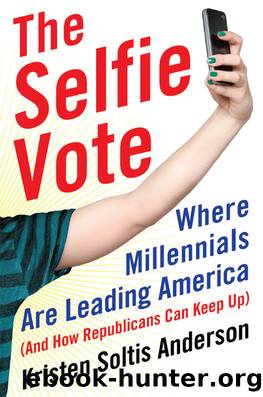The Selfie Vote: Where Millennials Are Leading America (And How Republicans Can Keep Up) by Kristen Soltis Anderson

Author:Kristen Soltis Anderson [Anderson, Kristen Soltis]
Language: eng
Format: azw3
Publisher: HarperCollins
Published: 2015-07-06T16:00:00+00:00
Americans owe over a trillion dollars in student loan debt—more than is owed on credit cards or auto loans. Student loans are not new, but the volume of debt certainly is. At the same time that the economic prospects for those without a college degree have grown dimmer, the cost of a college education has skyrocketed, leaving young people in a tough bind: eschew college and struggle to find a job, or get a degree and wind up with debt that still makes it hard to make ends meet.
Even when controlling for inflation, the cost of attending a four-year college is 2.3 times higher today than it was thirty years ago, and for a private college the increase has been six times higher.12 In 2008, it was estimated that as many as two-thirds of undergraduate students borrowed money to finance their education, with an average of nearly $25,000 in debt.13 Nearly four out of ten young adult households have student loan debt, with an average debt load of $13,000, according to the Pew Research Center, and those households with debt typically have a net worth far, far lower than that of households without student debt due to reliance on credit cards and other borrowing to make ends meet.14
Worse, nowadays millions are winding up with the worst of both worlds, paying tuition but not making it all the way to a degree or a credential, being saddled with the economic costs of school but none of the benefits.15 Some 40 percent of students who begin college do not finish it, and there are huge gaps between the number of low-income students and high-income students who do not complete a degree by age 24.16
Why has student debt ballooned in recent years, now totaling over a trillion dollars in the U.S.? “[It has] been enabled by a basic economic dynamic: an insatiable demand for a college education, at almost any price, and plenty of easy-to-secure loans, primarily from the federal government,” writes the New York Times.17 It’s certainly true that demand for college has gone through the roof. It is often said that “the bachelor’s degree is the new high school diploma,” and the unemployment data underscores the different economic outcomes people can expect with or without a college degree.
As more people have decided they want a degree, they have been able to get loans to pay for school quite easily. In general, we as a society think it is good that people can get financing for school, and that all debt is not equal: borrowing money for something like a sensible home or an education is “good debt,” while borrowing money for a flashy new car or to put a shopping spree on a credit card is “bad debt.” Student loan debt is arguably financing the most important investment of all, and with the best of intentions, we’ve created a system in which getting loan funding from the government is easy.
When someone buys a home or a car, the amount they can
Download
This site does not store any files on its server. We only index and link to content provided by other sites. Please contact the content providers to delete copyright contents if any and email us, we'll remove relevant links or contents immediately.
The Secret History by Donna Tartt(16608)
The Social Justice Warrior Handbook by Lisa De Pasquale(11485)
Thirteen Reasons Why by Jay Asher(7782)
This Is How You Lose Her by Junot Diaz(5753)
Weapons of Math Destruction by Cathy O'Neil(5029)
Zero to One by Peter Thiel(4817)
The Myth of the Strong Leader by Archie Brown(4785)
Promise Me, Dad by Joe Biden(4440)
Stone's Rules by Roger Stone(4412)
Beartown by Fredrik Backman(4404)
How Democracies Die by Steven Levitsky & Daniel Ziblatt(4392)
The Fire Next Time by James Baldwin(4336)
100 Deadly Skills by Clint Emerson(4070)
A Higher Loyalty: Truth, Lies, and Leadership by James Comey(4024)
Rise and Kill First by Ronen Bergman(4008)
The David Icke Guide to the Global Conspiracy (and how to end it) by David Icke(3875)
The Farm by Tom Rob Smith(3869)
Secrecy World by Jake Bernstein(3773)
The Doomsday Machine by Daniel Ellsberg(3725)
